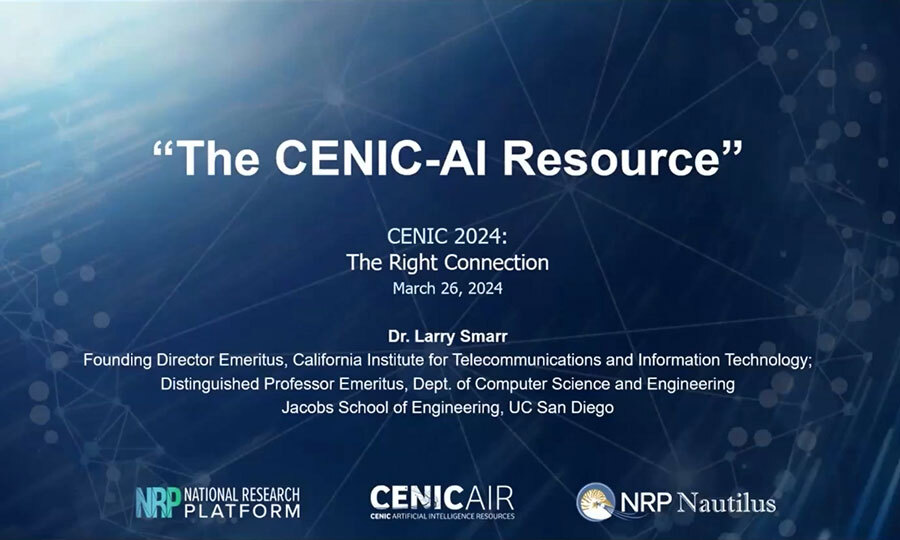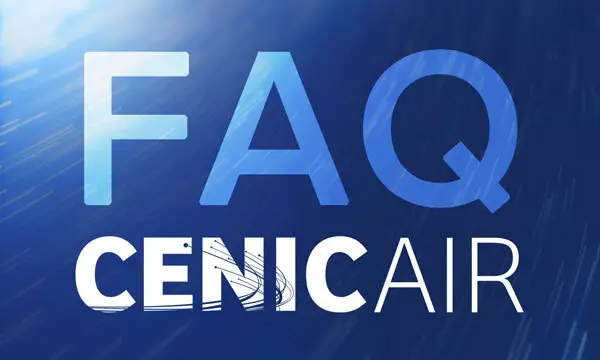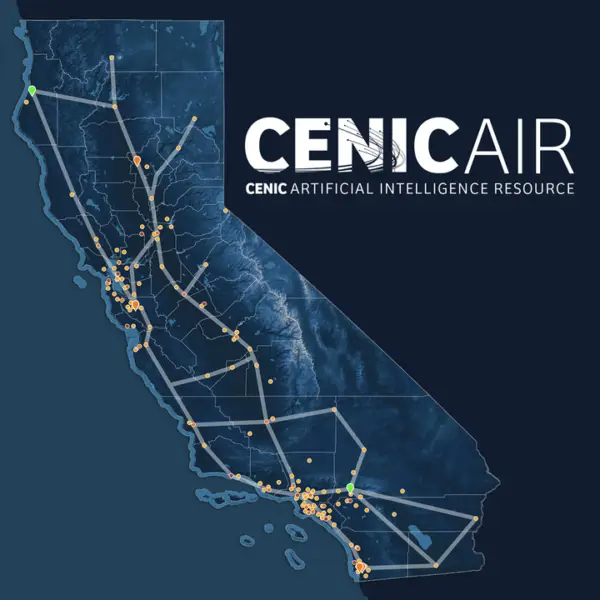- About
- Network
- Community
- Initiatives
- News
- Events
- Blog
- Publications
You Already Have Everything You Need: The CENIC AI Resource

International competition requires the US to rapidly increase its AI workforce. While AI research and development (R&D) in the United States is advancing rapidly, opportunities to pursue cutting-edge AI research and new AI applications are often inaccessible to researchers. Machine Learning and Artificial Intelligence are opening new career paths for students at all levels who will become the next facilitators of academic research and private sector innovation, with the potential to transform society in positive and beneficial ways. To facilitate this transformation there is a need for a national-level “AI Resource” that is open-access, scalable, and grown through the contributions of its user community. The need for this infrastructure has already been articulated in two National Science Foundation reports and one report from the National Artificial Intelligence Research Resource (NAIRR) Task Force. In addition, Congress has been asked to develop an AI research resource.
CENIC AIR Helps the Engagement of California’s Diverse Research & Education Communities
This resource, the infrastructure, and the communities that use it already exist in the United States in the form of the National Research Platform (NRP), and the California portion called the CENIC AI Resource (CENIC AIR). CENIC AIR provides California’s research and education communities a platform to enable their faculty and students to contribute constructively to this transformation and collaborate extensively with colleagues nationwide over the same infrastructure. For California to continue its leadership in AI, faculty, and students need access to training, research, and class lab facilities in a persistent, sustained infrastructure that will continue to evolve well into the future.
Machine Learning, Artificial Intelligence, and Data Science research and education applications need access to GPUs and other advanced compute technologies that CENIC AIR will support. With the CENIC AIR Platform, researchers and educators can also easily access cloud offerings such as Amazon AWS, Google Cloud Platform, and Microsoft Azure, as well as NSF HPC centers, should they need to scale beyond the National Research Platform (NRP) set of resources and have the allocations, funds, or cloud credits to use HPC cloud services.
CENIC AIR: the National Research Platform in California
The NRP is a member-owned and led national cyberinfrastructure created by a partnership of more than 50 institutions nationwide. It is led by researchers and cyberinfrastructure professionals at UC San Diego, and supported in part by grant awards from the National Science Foundation. Its users are among its owners who voluntarily contribute compute and storage resources for the entire community which are interconnected and accessed via regional and national research and education networks such as CENIC.
These software and hardware resources comprise a hypercluster known as Nautilus, designed to run big data applications using Kubernetes-based containerization for instantiation, management, and scaling.

While this ecosystem and its member community extend across the United States, the California portion, CENIC AIR, consists of high-performance compute and storage infrastructure voluntarily contributed to by members of the CENIC community (shown above). While distributed Nautilus platforms are connected into a distributed global cyberinfrastructure via regional and national (and international) research and education networks, the California portion runs on CENIC’s California Research and Education Network (CalREN).
CENIC AIR and the NRP provide much more than just infrastructure. The strong, accomplished research communities behind them offer invaluable mentorship and collaboration, including live networking conferences and events. This collaborative potential is even more powerful in California, where CENIC’s R&E community benefits from the cross-segmental 25-year head start by working together on network technology and its diverse applications.
CENIC AIR, connected to the NRP’s Nautilus infrastructure, is a scalable and robust ecosystem designed for, and responsive to, data science research needs as well as educational programs and positioned for much broader use by the CENIC community.
To that end, CENIC AIR would like to expand the user base by actively adding campuses and increasing faculty participation.
Providing AI Resources to a Broader Data Science Community
Given the importance of national access to cyberinfrastructure for research and education, CENIC AIR seeks to reach beyond the largest and most well-provisioned research institutions. For example, the NRP community has grown during the last 5 years from 10 to 135 campuses, including campuses in 21 of the 28 states and territories identified as part of the NSF’s Established Program to Stimulate Competitive Research (EPSCoR) and with 24 of them being Minority Serving Institutions (MSIs). Most California State Universities are MSIs,
Furthermore, many MSIs are not primarily research institutions, and do not operate a “Science DMZ.” A Science DMZ is a feature of the campus border router enabling a research-dedicated local area network that allows very large volumes of data traffic to bypass the common campus gateway firewall and primary campus network, thereby preventing the broader campus network from becoming overwhelmed by research traffic. Thanks to their collaborative user communities, CENIC and the NRP are ready to help such institutions architect, deploy, and support a Science DMZ, and to offer guidance on funding proposals for NSF CC* awards that can help campuses acquire the necessary on-premises AI compute equipment and campus networking improvements.
In addition, CENIC AIR partners can offer research project/mentor matching to help under-resourced campuses get connected.
Broadening Inclusion in California: The NRP & CENIC AIR is Increasingly Being Adopted by the California State University System
One example of the expansion of the original NRP user community is the California State University system, which offers several joint PhD programs, but primarily Master’s and undergraduate programs to its 430,000 students. In the year ahead, more CSU campuses are hoping to join CENIC AIR; with assistance from CENIC in network engineering, design, and implementation of Science DMZs for engaged California campuses.
Currently, CSU campuses with researchers using CENIC AIR include CSU Northridge, CSU San Bernardino, San Diego State University, San Jose State University, and Cal Poly Humboldt. CSU Sacramento and CSU San Marcos have recently expressed interest.
Any faculty member with a CILogin can get access to CENIC AIR. The first step for them is to create or join a project, which Kubernetes calls namespaces. They launch their containerized application on CENIC AIR, where Kubernetes orchestrates the movement of their containerized application to the appropriate hardware for execution on the infrastructure. Thousands of researchers, students, and staff have successfully done this, enabling many of them to train models on datasets and then apply the models to real-world data.
To get started without containerizing, a researcher/student can try out Nautilus by utilizing JupyterLab notebooks (specialized laptop-friendly software developed specifically for instructional purposes).

Researchers and their students then scale their activities from a single JupyterLab notebook to containerized applications with namespaces. This step up allows them to pursue research at a scale up to hundreds of GPU hours and thousands of CPU core hours operating on terabytes of data – and collaborate with any other institution using Nautilus’ shared storage.
Can a Campus Connect Equipment to CENIC AIR?
Should a campus choose to add resources to CENIC AIR and the NRP, it does so via the “bring your own resources” (BYOR) program. Campus IT staff can add GPU, CPU, FPGA, storage, or other networked equipment like Internet of Things (IoT) devices. CENIC Engineering and NRP’s technical staff are ready to assist campuses with BYOR and setting up Science DMZs.


CENIC AIR Introduced at 2024 Biennial Conference
CENIC AIR provides California’s research and education communities a platform for their faculty and students to contribute constructively to AI/ML research and collaborate with colleagues nationwide over the same infrastructure.
More video >
Frequently Asked Questions about CENIC AIR
This FAQ answers questions about the CENIC AI Resource both from faculty members who would like to use CENIC AIR for their research and instruction and from senior campus leaders and IT directors responsible for architecting and deploying network infrastructure.
Read the FAQ >
SDSC at UCSD and CENIC Expand AI Infrastructure in California
SDSC at UC San Diego and CENIC have developed a prescient AI education infrastructure called CENIC AI Resource (CENIC AIR) for K-12 education, public libraries, community colleges, the California State University (CSU) and the University of California (UC) campus systems.
Read more >




